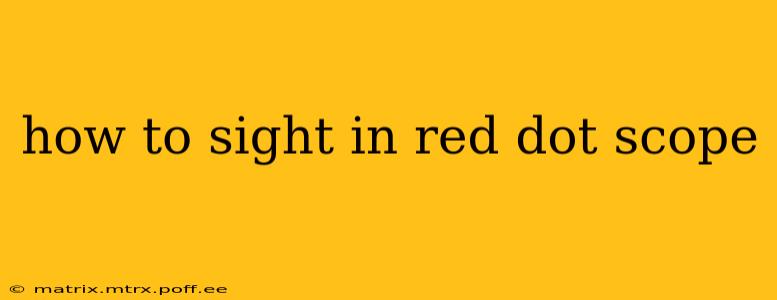Sighting in a red dot scope might seem daunting, but with the right approach and a little patience, it's a straightforward process. This guide will walk you through the steps, answering common questions along the way. Whether you're a seasoned shooter or a newcomer to optics, understanding how to zero your red dot is crucial for accurate shooting. We'll cover everything from choosing the right environment to troubleshooting common issues.
What tools and equipment do I need to sight in a red dot scope?
Before you begin, gather the necessary equipment:
- Your firearm: Ensure it's properly cleaned and lubricated.
- Your red dot sight: Make sure it's securely mounted on your firearm.
- Ammunition: Use the same type of ammunition you plan to use for hunting or target practice. Consistency is key.
- Target: A target with clearly defined aiming points is essential. Consider a target with multiple aiming points at varying distances.
- Shooting rest (optional but recommended): A shooting rest helps minimize movement and improves accuracy, especially during the sighting-in process.
- Tools for adjusting the scope: Most red dot sights use small adjustment knobs or turrets. Familiarize yourself with their operation before going to the range.
- Eye protection: Always wear eye protection when shooting a firearm.
- Ear protection: Protect your hearing with appropriate earmuffs or earplugs.
What is the best distance to sight in a red dot scope?
The optimal distance for sighting in a red dot sight depends on its intended use. Many shooters prefer a 25-yard zero. This provides a close-to-zero point of impact at various distances, useful for close-quarters shooting and self-defense scenarios. However, some prefer a 50-yard zero for longer-range engagements. The best distance is the one that best suits your shooting style and intended use.
How to zero your red dot sight at 25 yards?
Here's a step-by-step guide for zeroing your red dot at 25 yards:
- Securely mount your red dot sight: Ensure it's firmly attached to your firearm’s mounting rail.
- Set up your target: Place your target at a 25-yard distance.
- Assume a proper shooting stance: Use a comfortable and stable shooting position. A shooting rest is highly recommended.
- Aim and fire a three-shot group: Focus on aiming at the center of your target and gently squeeze the trigger.
- Observe your shot group: Note where your shots landed relative to your aiming point.
- Adjust your red dot sight: Use the adjustment knobs (typically labeled "windage" and "elevation") to adjust your point of impact. Most sights have a system of clicks, where each click corresponds to a specific adjustment in MOA (Minute of Angle) or other units. Consult your red dot sight's manual for specific instructions. Typically, a right-ward adjustment moves the point of impact to the right and an upward adjustment moves the point of impact up.
- Repeat steps 4-6: Continue firing three-shot groups and adjusting your red dot sight until your point of impact is centered on your target.
How often should I sight in my red dot scope?
The frequency of sighting in your red dot scope depends on several factors:
- How often you shoot: The more frequently you shoot, the more likely your zero might shift.
- Type of ammunition: Using different ammunition types can also affect your point of impact.
- Recoil: High-recoil firearms are more likely to cause the red dot sight to shift.
- Maintenance: Cleaning and handling your firearm improperly can affect zero.
It's a good practice to check your zero periodically, especially after transportation or significant use. If you notice your shots consistently missing your aim point, it’s time to re-sight your scope.
What if my red dot sight won't zero?
If you're having trouble zeroing your red dot, consider these possibilities:
- Incorrect mounting: Ensure your red dot sight is properly and securely mounted on your firearm. Loose or improperly mounted sights will lead to inaccurate results.
- Faulty sight: A defective red dot sight might be the culprit.
- Ammunition inconsistencies: Using different types or batches of ammunition can affect accuracy.
- Improper shooting technique: Ensure your shooting technique is consistent and accurate.
If you've ruled out these possibilities, consider seeking help from a professional gunsmith.
This comprehensive guide should help you successfully sight in your red dot scope. Remember safety first, and always practice responsible gun handling. Enjoy the improved accuracy your zeroed red dot will provide!
